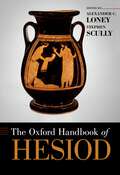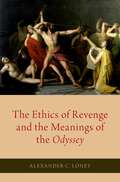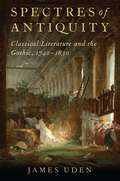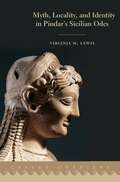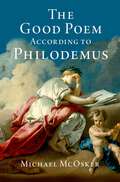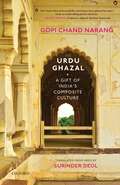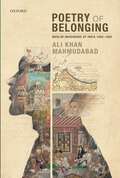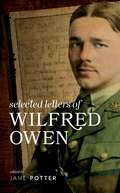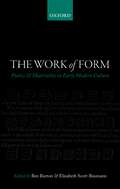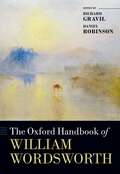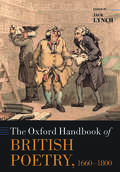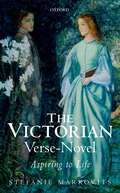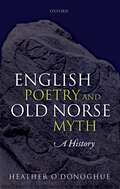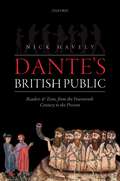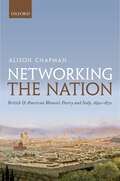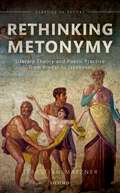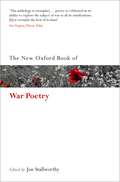- Table View
- List View
OHB HESIOD OHBK C (Oxford Handbooks)
by Alexander C. Loney, Stephen ScullyThis volume brings together 29 junior and senior scholars to discuss aspects of Hesiod's poetry and its milieu and to explore questions of reception over two and half millennia from shortly after the poems' conception to Twitter hashtags. Rather than an exhaustive study of Hesiodic themes, the Handbook is conceived as a guide through terrain, some familiar, other less charted, examining both Hesiodic craft and later engagements with Hesiod's stories of the gods and moralizing proscriptions of just human behavior. The volume opens with the "Hesiodic Question," to address questions of authorship, historicity, and the nature of composition of Hesiod's two major poems, the Theogony and Works and Days. Subsequent chapters on the archaeology and economic history of archaic Boiotia, Indo-European poetics, and Hesiodic style offer a critical picture of the sorts of questions that have been asked rather than an attempt to resolve debate. Other chapters discuss Hesiod's particular rendering of the supernatural and the performative nature of the Works and Days, as well as competing diachronic and synchronic temporalities and varying portrayals of female in the two poems. The rich story of reception ranges from Solon to comic books. These chapters continue to explore the nature of Hesiod's poetics, as different writers through time single out new aspects of his art less evident to earlier readers. Long before the advent of Christianity, classical writers leveled their criticism at Hesiod's version of polytheism. The relative importance of Hesiod's two major poems across time also tells us a tale of the age receiving the poems. In the past two centuries, artists and writers have come to embrace the Hesiodic stories for themselves for the insight they offer of the human condition but even as old allegory looks quaint to modern eyes new forms of allegory take form.
The Ethics of Revenge and the Meanings of the Odyssey
by Alexander C. LoneyThis book is the first in-depth examination of revenge in the Odyssey. The principal revenge plot of the Odyssey --Odysseus' surprise return to Ithaca after twenty away and his vengeance on Penelope's suitors -- is the act for which he is most celebrated. This story forms the backbone of the Odyssey. But is Odysseus' triumph over the suitors as univocally celebratory as is often assumed? Does the poem contain and even suggest other, darker interpretations of Odysseus' greatest achievement? This book offers a careful analysis of several other revenge plots in the Odyssey -- those of Orestes, Poseidon, Zeus, and the suitors' relatives. It shows how these revenge stories color one another with allusions (explicit and implicit) that connect them and invite audiences to interpret them in light of one another. These stories -- especially Odysseus' revenge upon the suitors -- inevitably turn out to have multiple meanings. One plot of revenge slips into another as the offender in one story becomes a victim to be avenged in the next. As a result, Odysseus turns out to be a much more ambivalent hero than has been commonly accepted. And in the Odyssey's portrayal, revenge is an unstable foundation for a community. Revenge also ends up being a tenuous narrative structure for an epic poem, as a natural end to cycles of vengeance proves elusive. This book offers a radical new reading of the seemingly happy ending of the poem.
The Ethics of Revenge and the Meanings of the Odyssey
by Alexander C. LoneyThis book is the first in-depth examination of revenge in the Odyssey. The principal revenge plot of the Odyssey --Odysseus' surprise return to Ithaca after twenty away and his vengeance on Penelope's suitors -- is the act for which he is most celebrated. This story forms the backbone of the Odyssey. But is Odysseus' triumph over the suitors as univocally celebratory as is often assumed? Does the poem contain and even suggest other, darker interpretations of Odysseus' greatest achievement? This book offers a careful analysis of several other revenge plots in the Odyssey -- those of Orestes, Poseidon, Zeus, and the suitors' relatives. It shows how these revenge stories color one another with allusions (explicit and implicit) that connect them and invite audiences to interpret them in light of one another. These stories -- especially Odysseus' revenge upon the suitors -- inevitably turn out to have multiple meanings. One plot of revenge slips into another as the offender in one story becomes a victim to be avenged in the next. As a result, Odysseus turns out to be a much more ambivalent hero than has been commonly accepted. And in the Odyssey's portrayal, revenge is an unstable foundation for a community. Revenge also ends up being a tenuous narrative structure for an epic poem, as a natural end to cycles of vengeance proves elusive. This book offers a radical new reading of the seemingly happy ending of the poem.
Spectres of Antiquity: Classical Literature and the Gothic, 1740-1830
by James UdenGothic literature imagines the return of ghosts from the past. But what about the ghosts of the classical past? Spectres of Antiquity is the first full-length study to describe the relationship between Greek and Roman culture and the Gothic novels, poetry, and drama of the eighteenth and early nineteenth centuries. Rather than simply representing the opposite of classical aesthetics and ideas, the Gothic emerged from an awareness of the lingering power of antiquity. The Gothic reflects a new and darker vision of the ancient world: no longer inspiring modernity through its examples, antiquity has become a ghost, haunting contemporary minds rather than guiding them. Through readings of works by authors including Horace Walpole, Ann Radcliffe, Matthew Lewis, Charles Brockden Brown, and Mary Shelley, Spectres of Antiquity argues that these authors' plots and ideas preserve the remembered traces of Greece and Rome. James Uden provides evidence for many allusions to ancient texts that have never previously been noted in scholarship, and he offers an accessible guide both to the Gothic genre and to the classical world to which it responds. In fascinating and compelling detail, Spectres of Antiquity rewrites the history of the Gothic, demonstrating that the genre was haunted by a far deeper sense of history than has previously been assumed.
Spectres of Antiquity: Classical Literature and the Gothic, 1740-1830
by James UdenGothic literature imagines the return of ghosts from the past. But what about the ghosts of the classical past? Spectres of Antiquity is the first full-length study to describe the relationship between Greek and Roman culture and the Gothic novels, poetry, and drama of the eighteenth and early nineteenth centuries. Rather than simply representing the opposite of classical aesthetics and ideas, the Gothic emerged from an awareness of the lingering power of antiquity. The Gothic reflects a new and darker vision of the ancient world: no longer inspiring modernity through its examples, antiquity has become a ghost, haunting contemporary minds rather than guiding them. Through readings of works by authors including Horace Walpole, Ann Radcliffe, Matthew Lewis, Charles Brockden Brown, and Mary Shelley, Spectres of Antiquity argues that these authors' plots and ideas preserve the remembered traces of Greece and Rome. James Uden provides evidence for many allusions to ancient texts that have never previously been noted in scholarship, and he offers an accessible guide both to the Gothic genre and to the classical world to which it responds. In fascinating and compelling detail, Spectres of Antiquity rewrites the history of the Gothic, demonstrating that the genre was haunted by a far deeper sense of history than has previously been assumed.
Myth, Locality, and Identity in Pindar's Sicilian Odes (Greeks Overseas)
by Virginia M. LewisMyth, Locality, and Identity argues that Pindar engages in a striking, innovative style of mythmaking that represents and shapes Sicilian identities in his epinician odes for Sicilian victors in the fifth century BCE. While Sicily has been thought to be lacking in local traditions for Pindar to celebrate, Lewis argues that the Sicilian odes offer examples of the formation of local traditions: the monster Typho whom Zeus defeated to become king of the gods, for example, now lives beneath Mt. Aitna; Persephone receives the island of Sicily as a gift from Zeus; and the Peloponnesian river Alpheos travels to Syracuse in pursuit of the local spring nymph Arethusa. By weaving regional and Panhellenic myth into the local landscape, as the book shows, Pindar infuses physical places with meaning and thereby contextualizes people, cities, and their rulers within a wider Greek framework. During this time period, Greek Sicily experienced a unique set of political circumstances: the inhabitants were continuously being displaced, cities were founded and resettled, and political leaders rose and fell from power in rapid succession. This book offers the first sustained analysis of myth in Pindar's odes for Sicilian victors across the island that accounts for their shared context. The nodes of myth and place that Pindar fuses in this poetry reinforce and develop a sense of place and community for citizens locally; at the same time, they raise the profile of physical sites and the cities attached to them for larger audiences across the Greek world. In addition to providing new readings of Pindaric odes and offering a model for the formation of Sicilian identities in the first half of the fifth century, the book contributes new insights into current debates on the relationship between myth and place in classical literature.
MYTH,LOCAL & IDENT PIND SICIL ODES GRO C (Greeks Overseas)
by Virginia M. LewisMyth, Locality, and Identity argues that Pindar engages in a striking, innovative style of mythmaking that represents and shapes Sicilian identities in his epinician odes for Sicilian victors in the fifth century BCE. While Sicily has been thought to be lacking in local traditions for Pindar to celebrate, Lewis argues that the Sicilian odes offer examples of the formation of local traditions: the monster Typho whom Zeus defeated to become king of the gods, for example, now lives beneath Mt. Aitna; Persephone receives the island of Sicily as a gift from Zeus; and the Peloponnesian river Alpheos travels to Syracuse in pursuit of the local spring nymph Arethusa. By weaving regional and Panhellenic myth into the local landscape, as the book shows, Pindar infuses physical places with meaning and thereby contextualizes people, cities, and their rulers within a wider Greek framework. During this time period, Greek Sicily experienced a unique set of political circumstances: the inhabitants were continuously being displaced, cities were founded and resettled, and political leaders rose and fell from power in rapid succession. This book offers the first sustained analysis of myth in Pindar's odes for Sicilian victors across the island that accounts for their shared context. The nodes of myth and place that Pindar fuses in this poetry reinforce and develop a sense of place and community for citizens locally; at the same time, they raise the profile of physical sites and the cities attached to them for larger audiences across the Greek world. In addition to providing new readings of Pindaric odes and offering a model for the formation of Sicilian identities in the first half of the fifth century, the book contributes new insights into current debates on the relationship between myth and place in classical literature.
The Good Poem According to Philodemus
by Michael McOskerThis book elucidates the poetics of Philodemus of Gadara, a first century BCE Epicurean philosopher and poet, whose On Poems survives in extensive fragments among the Herculaneum papyri. Although his treatise was primarily polemical and lacks positive exposition, his views are often recoverable from a careful reading of the debates, occasional direct evidence, and attention to his basic Epicurean commitments. His main critical principle is that form and content are inseparable and mutually-reinforcing: a change in one means a change in the other. The poet uses this marriage of form and content to create the psychological effect of the poem in the audience. This effect is hard to pin down exactly. Poems produce "additional thoughts" in the audience, and these entertain them. It seems clear that Philodemus expected good poets to arrange form and content suggestively, so that the poems could exert a lasting pull on the minds of the audience. Additionally, this book summarizes the views of Philodemus' opponents, the technical terminology of literary criticism in the Hellenistic period, and the history of Epicureanism's engagement with poetics. Epicurus did not write an On Poems but Metrodorus did, and this is probably Philodemus' touchstone for his own views. Zeno of Sidon, Demetrius Laco, Siro, and other Epicureans are examined as well. The book concludes with an appendix of topics examined by Philodemus, such as genre, mimesis, "appropriateness," utility, and various technical terms.
The Good Poem According to Philodemus
by Michael McOskerThis book elucidates the poetics of Philodemus of Gadara, a first century BCE Epicurean philosopher and poet, whose On Poems survives in extensive fragments among the Herculaneum papyri. Although his treatise was primarily polemical and lacks positive exposition, his views are often recoverable from a careful reading of the debates, occasional direct evidence, and attention to his basic Epicurean commitments. His main critical principle is that form and content are inseparable and mutually-reinforcing: a change in one means a change in the other. The poet uses this marriage of form and content to create the psychological effect of the poem in the audience. This effect is hard to pin down exactly. Poems produce "additional thoughts" in the audience, and these entertain them. It seems clear that Philodemus expected good poets to arrange form and content suggestively, so that the poems could exert a lasting pull on the minds of the audience. Additionally, this book summarizes the views of Philodemus' opponents, the technical terminology of literary criticism in the Hellenistic period, and the history of Epicureanism's engagement with poetics. Epicurus did not write an On Poems but Metrodorus did, and this is probably Philodemus' touchstone for his own views. Zeno of Sidon, Demetrius Laco, Siro, and other Epicureans are examined as well. The book concludes with an appendix of topics examined by Philodemus, such as genre, mimesis, "appropriateness," utility, and various technical terms.
The Urdu Ghazal: A Gift of India’s Composite Culture
by Gopi Chand NarangThe Urdu Ghazal presents the unique flowering of the ghazal as a by-product of India’s composite culture. It explores a variety of influences on the ghazal, including Sufism, Bhakti movement, and infusion of Rekhta and Persian languages and culture. The book elucidates classical ghazal forms that blossomed from the seeds sown by Amir Khusrau in the fourteenth century to achieve great heights of literary excellence during the next 300 years, notably in the works of great poets like Mir and Ghalib. It also illustrates different socio-political and cultural demands of changing times, primarily how the ghazal provided new creative models to deal with literary movements like progressivism, modernism, and postmodernism, through works of pioneering twentieth-century poets like Faiz Ahmed Faiz, Gulzar, and Javed Akhtar.
Poetry of Belonging: Muslim Imaginings of India 1850–1950
by Ali Khan MahmudabadPoetry of Belonging is an exploration of north-Indian Muslim identity through poetry at a time when the Indian nation state did not exist. Between 1850 and 1950, when precolonial forms of cultural traditions, such as the musha’irah, were undergoing massive transformations to remain relevant, certain Muslim ‘voices’ configured, negotiated, and articulated their imaginings of what it meant to be Muslim. Using poetry as an archive, the book traces the history of the musha’irah, the site of poetic performance, as a way of understanding public spaces through the changing economic, social, political, and technological contexts of the time. It seeks to locate the changing ideas of watan (homeland) and hubb-e watanī (patriotism) in order to offer new perspectives on how Muslim intellectuals, poets, political leaders, and journalists conceived of and expressed their relationship to India and to the transnational Muslim community. The volume aims to spark a renegotiation of identity and belonging, especially at a time when Muslim loyalty to India has yet again emerged as a politically polarizing question.
Selected Letters of Wilfred Owen
This new, select edition of Wilfred Owen's letters provides a fresh understanding of the poet's life in his own words. Wilfred Owen's fame as one of the great war poets of the twentieth century is unsurpassed, with Dulce et Decorum est possibly the defining piece of World War literature. Owen's letters reveal the man behind the cultural icon; human with all his foibles, whose 25 years were marked by great highs and lows, by emerging modernity, and the violence of war. Evocative, lyrical, and often surprisingly funny, the letters act as both autobiography and companion to the famous war poems. He was both an accomplished poet and one of the finest letter-writers of the twentieth century. Accompanied by new notes and new introduction, as well as previously redacted and omitted material, the new edition of Owen's Selected Letters brings together past and contemporary scholarship to provide fresh insights into Owen's character and poetic development.
Selected Letters of Wilfred Owen
by Mark SinclairThis new, select edition of Wilfred Owen's letters provides a fresh understanding of the poet's life in his own words. Wilfred Owen's fame as one of the great war poets of the twentieth century is unsurpassed, with Dulce et Decorum est possibly the defining piece of World War literature. Owen's letters reveal the man behind the cultural icon; human with all his foibles, whose 25 years were marked by great highs and lows, by emerging modernity, and the violence of war. Evocative, lyrical, and often surprisingly funny, the letters act as both autobiography and companion to the famous war poems. He was both an accomplished poet and one of the finest letter-writers of the twentieth century. Accompanied by new notes and new introduction, as well as previously redacted and omitted material, the new edition of Owen's Selected Letters brings together past and contemporary scholarship to provide fresh insights into Owen's character and poetic development.
The Work Of Form: Poetics And Materiality In Early Modern Culture
by Elizabeth Scott-Baumann Ben BurtonThe Work of Form: Poetics and Materiality in Early Modern Culture explores the resurgent interest in literary form and aesthetics in early modern english studies. Essays by leading international scholars reflect on the legacy of historicist approaches and on calls for a renewal of formalist analysis as both a tool and as a defence of our object of study as literary critics. This collection addresses the possibilities as well as the challenges of combining these critical traditions; it tests and reflects on these through practice. It also establishes new lines of enquiry by expanding definitions of form to include the material as well as theoretical implications of the term and explores the early modern roots of these connections. The period's most famous poets such as Sidney, Spenser, Shakespeare, Jonson, and Jonson appear alongside Anne Southwell, Thomas Campion, and many anonymous poets and songwriters. The Work of Form brings together contributors from literary history, historicism, manuscript study, prosodic theory, the history of music, history of the book, as well as print and manuscript culture. It represents avowedly political historical work, alongside aesthetic and theoretical frameworks, work bridging literature and music, and cognitive poetics. In bringing together these diverse commitments, it addresses urgent questions about how we can understand and analyse literary form in a historically-rooted way, and demands rigorous discussion about the status of formal and aesthetic considerations in editing, in literary criticism, and in teaching.
The Oxford Handbook of William Wordsworth (Oxford Handbooks)
The Oxford Handbook of William Wordsworth deploys its forty-seven original essays to present a stimulating account of Wordsworth's life and achievement and to map new directions in criticism. In addition to twenty-two essays wholly on Wordsworth's poetry, other essays return to the poetry while exploring other dimensions of the life and work of the major Romantic poet. The result is a dialogic exploration of many major texts and problems in Wordsworth scholarship. This uniquely comprehensive handbook is structured so as to present, in turn, Wordsworth's life, career, and networks; aspects of the major lyrical and narrative poetry; components of 'The Recluse'; his poetical inheritance and his transformation of poetics; the variety of intellectual influences upon his work, from classical republican thought to modern science; his shaping of modern culture in such fields as gender, landscape, psychology, ethics, politics, religion, and ecology; and his 19th- and 20th-century reception-most importantly by poets, but also in modern criticism and scholarship.
The Oxford Handbook of William Wordsworth (Oxford Handbooks)
by Richard Gravil and Daniel RobinsonThe Oxford Handbook of William Wordsworth deploys its forty-seven original essays to present a stimulating account of Wordsworth's life and achievement and to map new directions in criticism. In addition to twenty-two essays wholly on Wordsworth's poetry, other essays return to the poetry while exploring other dimensions of the life and work of the major Romantic poet. The result is a dialogic exploration of many major texts and problems in Wordsworth scholarship. This uniquely comprehensive handbook is structured so as to present, in turn, Wordsworth's life, career, and networks; aspects of the major lyrical and narrative poetry; components of 'The Recluse'; his poetical inheritance and his transformation of poetics; the variety of intellectual influences upon his work, from classical republican thought to modern science; his shaping of modern culture in such fields as gender, landscape, psychology, ethics, politics, religion, and ecology; and his 19th- and 20th-century reception-most importantly by poets, but also in modern criticism and scholarship.
The Oxford Handbook of British Poetry, 1660-1800 (Oxford Handbooks)
In the most comprehensive and up-to-date overview of the poetry published in Britain between the Restoration and the end of the eighteenth century, forty-four authorities from six countries survey the poetry of the age in all its richness and diversity—serious and satirical, public and private, by men and women, nobles and peasants, whether published in deluxe editions or sung on the streets. The contributors discuss poems in social contexts, poetic identities, poetic subjects, poetic form, poetic genres, poetic devices, and criticism. Even experts in eighteenth-century poetry will see familiar poems from new angles, and all readers will encounter poems they've never read before. The book is not a chronologically organized literary history, nor an encyclopaedia, nor a collection of thematically related essays; rather it is an attempt to provide a systematic overview of these poetic works, and to restore it to a position of centrality in modern criticism.
The Oxford Handbook of British Poetry, 1660-1800 (Oxford Handbooks)
by Jack LynchIn the most comprehensive and up-to-date overview of the poetry published in Britain between the Restoration and the end of the eighteenth century, forty-four authorities from six countries survey the poetry of the age in all its richness and diversity—serious and satirical, public and private, by men and women, nobles and peasants, whether published in deluxe editions or sung on the streets. The contributors discuss poems in social contexts, poetic identities, poetic subjects, poetic form, poetic genres, poetic devices, and criticism. Even experts in eighteenth-century poetry will see familiar poems from new angles, and all readers will encounter poems they've never read before. The book is not a chronologically organized literary history, nor an encyclopaedia, nor a collection of thematically related essays; rather it is an attempt to provide a systematic overview of these poetic works, and to restore it to a position of centrality in modern criticism.
The Victorian Verse-Novel: Aspiring to Life
by Stefanie MarkovitsThe Victorian Verse-Novel: Aspiring to Life considers the rise of a hybrid generic form, the verse-novel, in the second half of the nineteenth century. Such poems combined epic length with novelistic plots in the attempt to capture not a heroic past but the quotidian present. Victorian verse-novels also tended to be rough-mixed, their narrative sections interspersed with shorter, lyrical verses in varied measures. In flouting the rules of contemporary genre theory, which saw poetry as the purview of the eternal and ideal and relegated the everyday to the domain of novelistic prose, verse-novels proved well suited to upsetting other hierarchies, as well, including those of gender and class. The genre's radical energies often emerge from the competition between lyric and narrative drives, between the desire for transcendence and the quest to find meaning in what happens next; the unusual marriage plots that structure such poems prove crucibles of these rival forces. Generic tensions also yield complex attitudes towards time and space: the book's first half considers the temporality of love, while its second looks at generic geography through the engagement of novels in verse with Europe and the form's transatlantic travels. Both well-known verse-novels (Elizabeth Barrett Browning's Aurora Leigh, Arthur Hugh Clough's Amours de Voyage, Coventry Patmore's The Angel in the House) and lesser-known examples are read closely alongside a few nearly related works (Tennyson's Idylls of the King, Robert Browning's The Ring and the Book). An Afterword traces the verse-novel's substantial influence on the modernist novel.
English Poetry and Old Norse Myth: A History
by Heather O'DonoghueEnglish Poetry and Old Norse Myth: A History traces the influence of Old Norse myth — stories and poems about the familiar gods and goddesses of the pagan North, such as Odin, Thor, Baldr and Freyja — on poetry in English from Anglo-Saxon times to the present day. Especial care is taken to determine the precise form in which these poets encountered the mythic material, so that the book traces a parallel history of the gradual dissemination of Old Norse mythic texts. Very many major poets were inspired by Old Norse myth. Some, for instance the Anglo-Saxon poet of Beowulf, or much later, Sir Walter Scott, used Old Norse mythic references to lend dramatic colour and apparent authenticity to their presentation of a distant Northern past. Others, like Thomas Gray, or Matthew Arnold, adapted Old Norse mythological poems and stories in ways which both responded to and helped to form the literary tastes of their own times. Still others, such as William Blake, or David Jones, reworked and incorporated celebrated elements of Norse myth - valkyries weaving the fates of men, or the great World Tree Yggdrasill on which Odin sacrificed himself - as personal symbols in their own poetry. This book also considers less familiar literary figures, showing how a surprisingly large number of poets in English engaged in individual ways with Old Norse myth. English Poetry and Old Norse Myth: A History demonstrates how attitudes towards the pagan mythology of the north change over time, but reveals that poets have always recognized Old Norse myth as a vital part of the literary, political and historical legacy of the English-speaking world.
Dante's British Public: Readers and Texts, from the Fourteenth Century to the Present
by Nick HavelyThis is the first account of Dante's reception in English to address full chronological span of that process. Individual authors and periods have been studied before, but Dante's British Public takes a wider and longer view, using a selection of vivid and detailed case studies to record and place in context some of the wider conversations about and appropriations of Dante that developed in Britain across more than six centuries, as access to his work extended and diversified. Much of the evidence is based on previously unpublished material in (for example) letters, journals, annotations and inventories and is drawn from archives in the UK and across the world, from Milan to Mumbai and from Berlin to Cape Town. Throughout, the role of Anglo-Italian cultural contacts and intermediaries in shaping the public understanding of Dante in Britain is given prominence - from clerics and merchants around Chaucer's time, through itinerant scholars, collectors and tourists in the early modern period, to the exiles and expatriates of the nineteenth and twentieth centuries. The final chapter brings the story up to the present, showing how the poet's work has been seen (from the fourteenth century onwards) as accessible to 'the many', and demonstrating some of the means by which Dante has reached a yet wider British public over the past century, particularly through translation, illustration, and various forms of performance.
Networking the Nation: British and American Women's Poetry and Italy, 1840-1870
by Alison ChapmanHow did nineteenth-century women's poetry shift from the poetess poetry of lyric effusion and hyper-femininity to the muscular epic of Elizabeth Barrett Browning's Aurora Leigh? Networking the Nation re-writes women's poetic traditions by demonstrating the debt that Barrett Browning's revolutionary poetics owed to a circle of American and British women poets living in Florence and campaigning in their poetry and in their salons for Italian Unification. These women poets—Isa Blagden, Elizabeth Kinney, Eliza Ogilvy, and Theodosia Garrow Trollope—formed with Barrett Browning a network of poetry, sociability, and politics, which was devoted to the mission of campaigning for Italy as an independent nation state. In their poetic experiments with the active lyric voice, in their forging of a transnational persona through the periodical press, in their salons and spiritualist séances, the women poets formed a network that attempted to assert and perform an independent unified Italy in their work. Networking the Nation maps the careers of these expatriate women poets who were based in Florence in the key years of Risorgimento politics, racing their transnational social and print communities, and the problematic but schismatic shift in their poetry from the conventional sphere of the poetess. In the fraught and thrilling engagement with their adopted nation's revolutionary turmoil, and in their experiments with different types of writing agency, the women poets in this book offer revolutions of other kinds: revolutions of women's poetry and the very act of writing.
Rethinking Metonymy: Literary Theory and Poetic Practice from Pindar to Jakobson (Classics in Theory Series)
by Sebastian MatznerAlthough metonymy has long been recognized as being a central device in poetic language, it has received little critical attention in its own right. Not only has this created a gap in literary analytical scholarship which needs to be addressed, but it has also allowed for problematic appropriations of metonymy as a critical concept now widely in use in structuralist studies across the humanities. Rethinking Metonymy is the first monograph to confront and resolve these issues. It advances the theory of poetic language by developing a ground-breaking new definition of metonymy on the basis of an evaluation of examples in Greek tragedy and lyric poetry, considering these in conjunction with examples from classicizing and Romantic German poetry for the purposes of illustration and comparison, including works by Goethe, Schiller, and Hölderlin. In addition to establishing the fundamental principle, different conformations, and aesthetic effects of this important poetic device, the volume also demonstrates how the new arguments it offers have the potential to set an agenda for far-reaching reconsiderations in literary studies and beyond. It mobilizes analytical insights into the inner workings of metonymy by examining three case studies designed to explore the trope in critical practice, covering its role in creating a 'hellenizing' style, what happens to it in 'classic' German translations of Aeschylus' Agamemnon, and critically re-assessing its modern re-appropriations as a structural-semiotic paradigm. Connecting classical perspectives with modern linguistic and literary theory, Rethinking Metonymy is a compelling and authoritative analysis that rehabilitates and brings much-needed clarity to an oft-neglected literary device. Its combination of in-depth engagement with classical literature and cross-cultural and cross-linguistic comparison makes it an invaluable resource not only to specialists in Greek poetry, but also to students and scholars engaged in literary analysis, translation criticism, and structuralist studies across a much wider range of disciplines.
The New Oxford Book of War Poetry (Oxford Books of Prose & Verse)
by Jon StallworthyThere can be no area of human experience that has generated a wider range of powerful feelings than war. Jon Stallworthy's classic and celebrated anthology spans centuries of human experience of war, from Homer's Iliad, through the First and Second World Wars, the Vietnam War, and the wars fought since. This new edition, published to mark the centenary of the outbreak of the First World War, includes a new introduction additonal poems from David Harsent and Peter Wyton amongst others. The new selection provides improved coverage of the two World Wars and the Vietnam War, and new coverage of the wars of the late twentieth and early twenty-first centuries.
The New Oxford Book of War Poetry (Oxford Books Of Prose And Verse Ser.)
by Jon StallworthyThere can be no area of human experience that has generated a wider range of powerful feelings than war. Jon Stallworthy's classic and celebrated anthology spans centuries of human experience of war, from Homer's Iliad, through the First and Second World Wars, the Vietnam War, and the wars fought since. This new edition, published to mark the centenary of the outbreak of the First World War, includes a new introduction additonal poems from David Harsent and Peter Wyton amongst others. The new selection provides improved coverage of the two World Wars and the Vietnam War, and new coverage of the wars of the late twentieth and early twenty-first centuries.
